Microstructural Deformation and the Age of Monazite-(Ce) from Diatectite Granite in the Jarva-Varaka Structure (Kola Region, Russia)
Abstract
:1. Introduction

2. Geological Setting
3. Materials and Methods
3.1. Materials
3.2. Methods
4. Results
4.1. Chemical Composition of Monazite (WDS Data)
4.2. EBSD Mapping
4.3. U-Pb ID-TIMS and CHIME Dating of Monazite
4.4. Chemical Composition (EDS Data) and CHIME Age of Monazite Neoblastic Domains
5. Discussion
5.1. EBSD Pattern
5.2. Monazite Age
6. Conclusions
Author Contributions
Funding
Data Availability Statement
Acknowledgments
Conflicts of Interest
References
- Masaitis, V.L.; Danilin, A.N.; Mashchak, M.S.; Raikhlin, A.I.; Selivanovskaia, T.V.; Shadenkov, E.M. Geology of Astroblemes; Nedra: Leningrad, USSR, 1980; 231p. (In Russian) [Google Scholar]
- Glikson, A.Y. The Asteroid Impact Connection of Planetary Evolution; Springer-Briefs: Dordrecht, The Netherlands, 2013; 150p. [Google Scholar]
- Melosh, H.J. Impact Cratering: A Geological Process; Oxford University Press: New York, NY, USA, 1989; 245p. [Google Scholar]
- Gibson, R.L.; Armstrong, R.A.; Reimold, W.U. The age and thermal evolution of the Vredefort impact structure: A single-grain U-Pb zircon study. Geochim. Cosmoch. Acta 1997, 61, 1531–1540. [Google Scholar] [CrossRef]
- Davis, D.W. Sub-million year age resolution of Precambrian igneousevents by thermal extraction (TE-TIMS) Pb dating of zircon: Applicationto crystallization of the Sudbury impact melt sheet. Geology 2008, 36, 383–386. [Google Scholar] [CrossRef]
- McDonald, F.A.; Bunring, J.A.; Cina, C.E. Yarrabubba—A large, deeply eroded impact structure in the Yilgarn Craton, Western Australia. Earth Planet Sci. Lett. 2003, 213, 235–247. [Google Scholar] [CrossRef]
- Erickson, T.M.; Kirkland, C.L.; Timms, N.E.; Cavosie, A.J.; Davison, T.M. Precise radiometric age establishes Yarrabubba, Western Australia, as Earth’s oldest recognized meteorite impact structure. Nat. Commun. 2020, 11, 300. [Google Scholar] [CrossRef]
- Li, S.-S.; Keerthy, S.; Santosh, M.; Singh, S.P.; Deering, C.D.; Satyanarayanan, M.; Praveen, M.N.; Aneeshkumar, V.; Indu, G.K.; Anilkumar, Y.; et al. Anatomy of impactites and shocked zircon grains from Dhala reveals Paleoproterozoic meteorite impact in the Archean basement rocks of Central India. Gondwana Res. 2018, 54, 81–101. [Google Scholar] [CrossRef]
- Mashchak, M.S.; Naumov, M.V. The Suavjärvi impact structure, NW Russia. Meteorit. Planet Sci. 2012, 47, 1644–1658. [Google Scholar] [CrossRef]
- French, B.M. Traces of Catastrophe: A Handbook of Shock-Metamorphic Effects in Terrestrial Meteorite Impact Structures; Lunar and Planetary Institute: Houston, TX, USA, 1998; 130p. [Google Scholar]
- Grieve, R.A.F. Extraterrestrial impacts on earth: The evidence and the consequences. In Meteorites: Flux with Time and Impact Effects; Grady, M.M., Hutchison, R., McCall, G.J.H., Rothery, D., Eds.; Geological Society, London, Special Publication: London, UK, 1998; Volume 140, pp. 105–131. [Google Scholar]
- French, B.M.; Koeberl, C. The convincing identification of terrestrial meteorite impact structures: What works, what doesn’t, and why. Earth Sci. Rev. 2010, 98, 123–170. [Google Scholar] [CrossRef]
- Reimold, W.U.; Leroux, H.; Gibson, R.L. Shocked and thermally-metamorphosed zircon from the Vredefort impact structure, South Africa. Eur. J. Mineral. 2002, 14, 859–868. [Google Scholar] [CrossRef]
- Gucsik, A.; Koeberl, C.; Brandstätter, F.; Reimold, W.U.; Libowitzky, E. Cathodoluminescence, electron microscopy, and Raman spectroscopy of experimentally shock-metamorphosed zircon. Earth Planet Sci. Lett. 2002, 202, 495–509. [Google Scholar] [CrossRef]
- Gucsik, A.; Zhang, M.; Koeberl, C.; Salje, E.K.H.; Redfern, S.A.T.; Pruneda, J.M. Infrared and Raman spectra of ZrSiO4 experimentally shocked at high pressures. Miner. Mag. 2004, 68, 801–811. [Google Scholar] [CrossRef]
- Wittmann, A.; Kenkmann, T.; Schmitt, R.T.; Stöffler, D. Shock-metamorphosed zircon in terrestrial impact craters. Meteorit. Planet. Sci. 2006, 41, 433–454. [Google Scholar] [CrossRef]
- Erickson, T.M.; Cavosie, A.J.; Pearce, M.A.; Timms, N.E.; Reddy, S.M. Empirical constraints on shock features in monazite using shocked zircon inclusions. Geology 2016, 44, 635–638. [Google Scholar] [CrossRef]
- Timms, N.E.; Erickson, T.M.; Pearce, M.A.; Cavosie, A.J.; Schmieder, M.; Tohver, E.; Reddy, S.M.; Zanetti, M.R.; Nemchin, A.A.; Wittmann, A. A pressure-temperature phase diagram for zircon at extreme conditions. Earth Sci. Rev. 2017, 165, 185–202. [Google Scholar] [CrossRef]
- Cavosie, A.J.; Erickson, T.M.; Montalvo, P.; Prado, D.; Cintron, N.; Gibbon, R.J. The Rietputs Formation in South Africa: A Pleistocene Fluvial Archive of Meteorite Impact Unique to the Kaapvaal Craton; Microstructural geochronology; Lattice to Atom-Scale Records of Planetary Evolution. AGU Monograph; AGU-Wiley: Hoboken, NJ, USA, 2018; pp. 203–224. [Google Scholar]
- Vishnevsky, S.A.; Pal’chik, N.A.; Moroz, T.N.; Leonova, I.V. Shock Metamorphism of Carbonaceous Matter in Impactites of the Janisjärvi Astrobleme, Karelia. Dokl Earth Sci. 2002, 387A, 1024–1027. [Google Scholar]
- Huber, M.; Plado, J.; Ferrière, L. Oldest Impact Structures on Earth—The Case Study of the Suavjärvi Structure (Russia). Large Meteor. Impacts Planet. Evol. V 2013, 1737, 3073. [Google Scholar]
- Nerovich, L.I.; Bayanova, T.B.; Kunakkuzin, E.L.; Bazai, A.V.; Nekipelov, D.A. New results of geological-petrographic and geochemical study of the stratified massif of Jarva-varaka, Monchegorsk ore area. Proc. FSS GI KSC RAS 2015, 12, 141–146. (In Russian) [Google Scholar]
- Nerovich, L.I.; Kaulina, T.V.; Bayanova, T.B.; Ilchenko, V.L.; Kunakkuzin, E.L.; Bazai, A.V.; Mudruk, S.V.; Borisenko, E.S.; Sosnovskaya, M.F. Granophyre norites and diorites of the Jarva- Varaka massif (Monchegorsk ore area, Kola Region, Russia): Geology, petrography, geochemistry, geochronology and origin. Geochem. Int. 2023, 61, 572–592. [Google Scholar] [CrossRef]
- Grieve, R.A.F. An impact model for the Sudbury structure. Proc. Sudbury-Noril’sk Symp. Ont. Geol. Surv. Spec. Vol. 1994, 5, 119–132. [Google Scholar]
- Naldrett, A.J. Magmatic Sulfide Deposits: Geology, Geochemistry, and Exploration; Springer: Berlin, Germany, 2004; 727p. [Google Scholar]
- Kaulina, T.V.; Nerovich, L.I.; Il’chenko, V.L.; Lialina, L.M.; Kunakkuzin, E.L.; Ganninbal, M.A.; Mudruk, S.V.; Elizarov, D.V.; Borisenko, E.S. Astroblems in the early Earth history: Precambrian impact structures of the Kola-Karelian region (East Baltic shield). In Geological and Geo-Environmental Processes on Earth; Springer: Singapore, 2021; pp. 25–37. [Google Scholar]
- Schärer, U.; Deutsch, A. Isotope systematic and shock-wave metamorphism: II. U-Pb and Rb-Sr in naturally shocked rocks; the Haughton Impact Structure, Canada. Geochim. Cosmoch. Acta 1990, 54, 3435–3447. [Google Scholar] [CrossRef]
- Silva, D.; Lana, C.; de Souza Filho, C.R. Petrographic and geochemical characterization of the granitic rocks of the Araguainha impact crater, Brazil. Meteorit. Planet Sci. 2016, 51, 443–467. [Google Scholar] [CrossRef]
- Erickson, T.M.; Timms, N.E.; Kirkland, C.L.; Tohver, E.; Cavosie, A.J.; Pearce, M.A.; Reddy, S.M. Shocked monazite chronometry: Integrating microstructural and in situ isotopic age data for determining precise impact ages. Contrib. Miner. Pet. 2017, 172, 11. [Google Scholar] [CrossRef]
- Fougerouse, D.; Cavosie, A.J.; Erickson, T.; Reddy, S.M.; Cox, M.A.; Saxey, D.W.; Rickard, W.D.A.; Wingate, M.T.D. A new method for dating impact events—Thermal dependency on nanoscale Pb mobility in monazite shock twins. Geochim. Cosmochim. Acta 2021, 314, 381–396. [Google Scholar] [CrossRef]
- Moser, D.E. Dating the shock wave and thermal imprint of the giant Vredefort impact, South Africa. Geology 1997, 25, 7–10. [Google Scholar] [CrossRef]
- Cavosie, A.J.; Quintero, R.R.; Radovan, H.A.; Moser, D.E. A record of ancient cataclysm in modern sand: Shock microstructures in detrital minerals from the Vaal River, Vredefort Dome, South Africa. Bulletin 2010, 122, 1968–1980. [Google Scholar] [CrossRef]
- Kovaleva, E.; Dixon, R. Properties of Impact-Related Pseudotachylite and Associated Shocked Zircon and Monazite in the Upper Levels of a Large Impact Basin: A Case Study from the Vredefort Impact Structure. Minerals 2020, 10, 1053. [Google Scholar] [CrossRef]
- Smolkin, V.F.; Fedotov, Z.A.; Neradovsky, Y.N.; Bayanova, T.B.; Borisova, V.V.; Glasnev, V.N.; Dedyukhin, A.N.; Orsoev, D.A.; Ohnenstetter, M.; Ohnenstetter, D.; et al. Layered Intrusions of the Monchegorsk Ore Region: Petrology, Mineralization, Isotopy, Deep Structure; KSC RAS: Apatity, Russia, 2004; 177p. (In Russian) [Google Scholar]
- Sosnovskaya, M.A.; Nerovich, L.I. Petrographic and petrochemical characterization of gneisses and granitoids framing the Jarva-varaka massif. Proc. FSS GI KSC RAS 2020, 17, 515–519. (In Russian) [Google Scholar]
- Krogh, T.E. A low-contamination method for hydrothermal decomposition of zircons and extraction of U and Pb for isotopic age determinations. Geochim. Cosmochim. Acta 1973, 37, 485–494. [Google Scholar] [CrossRef]
- Kaulina, T.V.; Kalinin, A.A.; Il’chenko, V.L.; Gannibal, M.A.; Avedisyan, A.A.; Elizarov, D.V.; Nerovich, L.I.; Nitkina, E.A. Age and Formation Conditions of U Mineralization in the Litsa Area and the Salla-Kuolajarvi Zone (Kola Region, Russia). Minerals 2018, 8, 563. [Google Scholar] [CrossRef]
- Suzuki, K.; Adachi, M. Precambrian provenance and Silurian metamorphism of the Tsubonosawa paragneiss in the South Kitakami terrane, Northeast Japan, revealed by the chemical Th-U-total Pb isochron ages of monazite, zircon and xenotime. Geochem. J. 1991, 25, 357–376. [Google Scholar] [CrossRef]
- Montel, J.-M.; Foret, S.; Veschambre, M.; Nicollet, C.; Provost, A. Electron microprobe dating of monazite. Chem. Geol. 1996, 131, 37–53. [Google Scholar] [CrossRef]
- Votyakov, S.L.; Shchapova, Y.V.; Hiller, V.V. Crystal Chemistry and Physics of Radiation-Thermal Effects in a Number of U-Th-Containing Minerals as a Basis for Their Chemical Microprobe Dating; IGG UB RAS: Ekaterinburg, Russia, 2011; 336p. (In Russian) [Google Scholar]
- Ludwig, K.R. User’s Manual for Isoplot Version 3.75–4.15: A Geochronological Toolkit for Microsoft Excel; Berkeley Geochronology Center: Berkeley, CA, USA, 2012; p. 5, Special Publication. [Google Scholar]
- Erickson, T.M.; Pearce, M.A.; Taylor, R.J.M.; Timms, N.E.; Clark, C.; Reddy, S.M.; Buick, I.S. Deformed monazite yields high-temperature tectonic ages. Geology 2015, 43, 383–386. [Google Scholar] [CrossRef]
- Hay, R.; Marshall, D. Deformation twinning in monazite. Acta Mater. 2003, 51, 5235–5254. [Google Scholar] [CrossRef]
- Schulz, B.; Lange, J.-M.; Krause, J.; Czygan, D. Monazite in lithoclasts of suevite impact breccia in the Nördlinger Ries (Bavaria, Germany) and its Th-U-Pb dating by electron probe microanalysis. Z. Dtsch. Ges. Geowiss. 2022. [Google Scholar] [CrossRef]
- Levchenkov, O.A.; Levsky, L.K.; Nordgulen, Ø.; Dobrzhinetskaya, L.F.; Vetrin, V.R.; Cobbing, J.; Nilsson, L.P.; Sturt, B.A. U-Pb zircon ages from Sörvaranger, Norway and the western part of the Kola Peninsula, Russia. Nor. Geol. Unders. Spec. Publ. 1995, 7, 29–47. [Google Scholar]
- Gardés, E.; Jaoul, O.; Montel, J.-M.; Seydoux-Guillaume, A.-M.; Wirth, R. Pb diffusion in monazite: An experimental study of Pb2++Th4+ = 2Nd3+ interdiffusion. Geochim. Cosmochim. Acta 2006, 70, 2325–2336. [Google Scholar] [CrossRef]
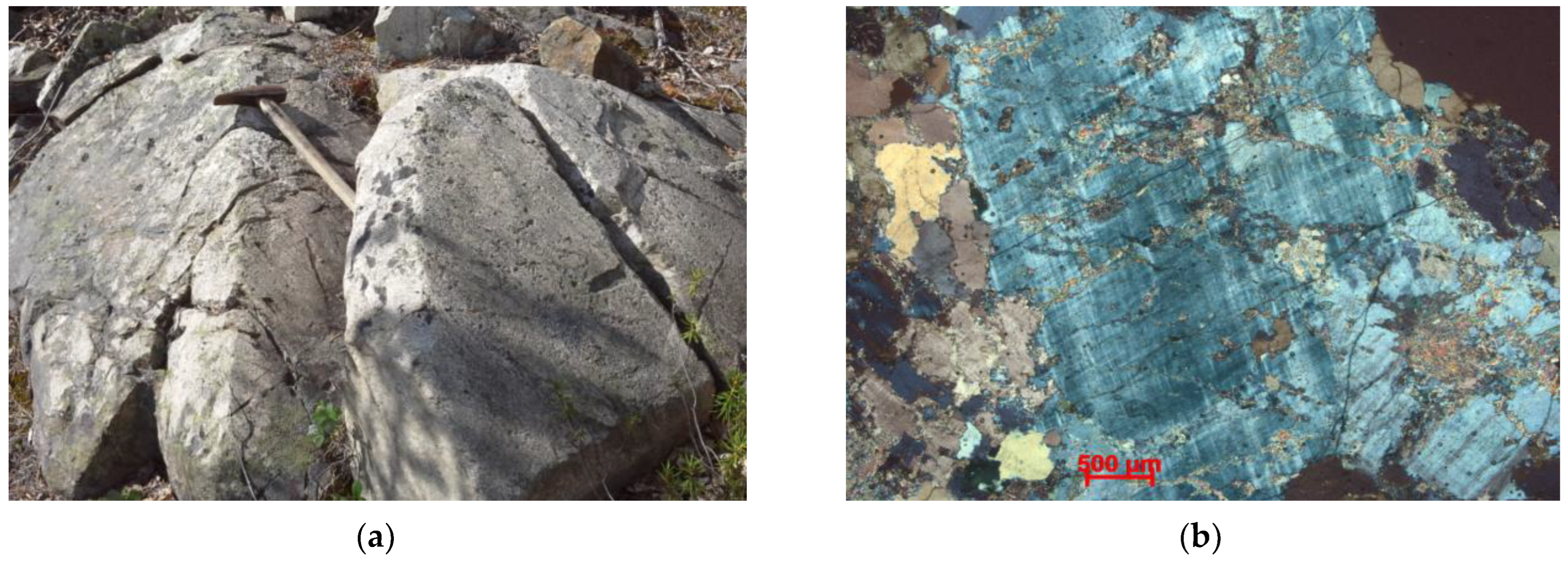
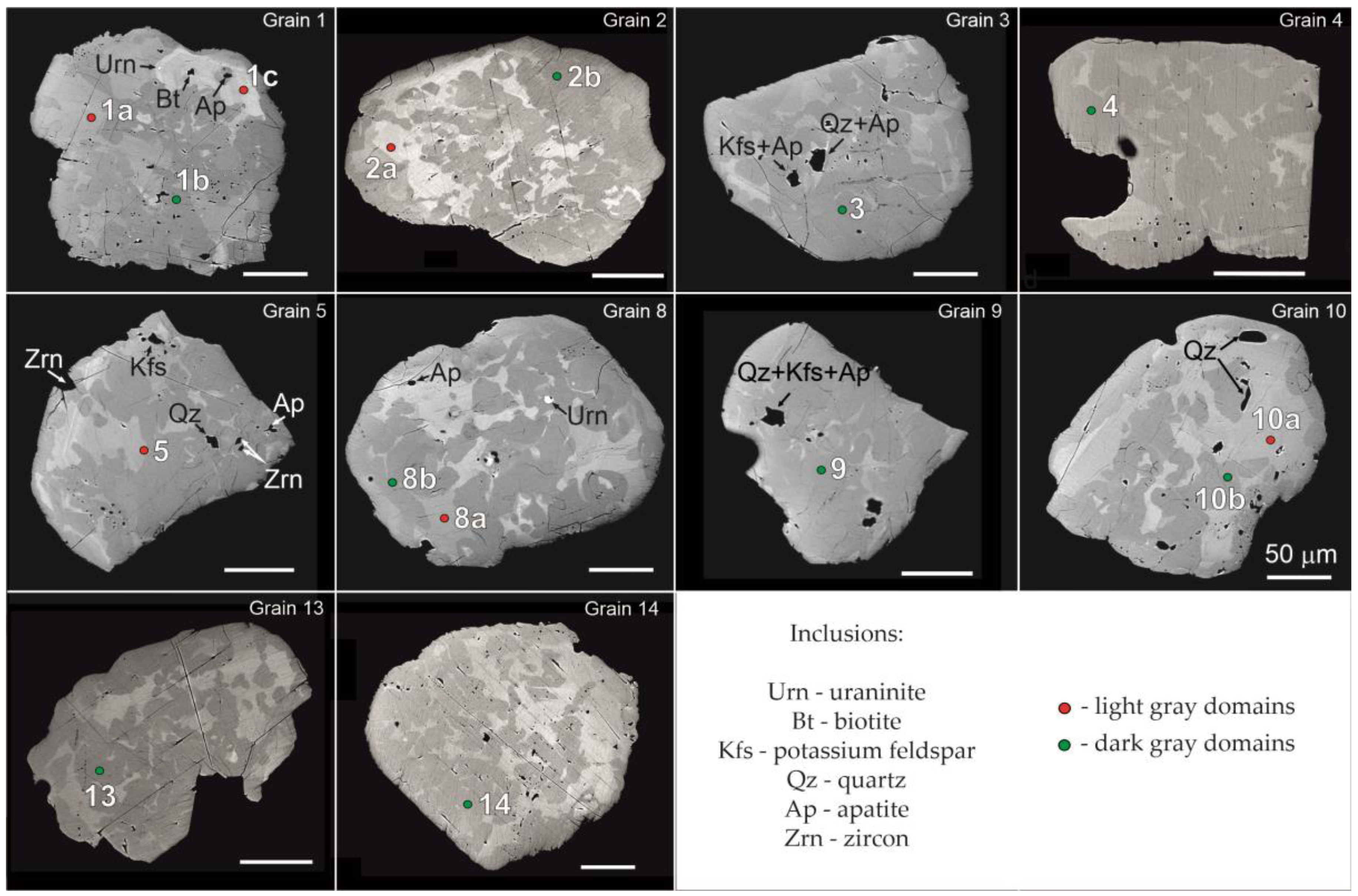
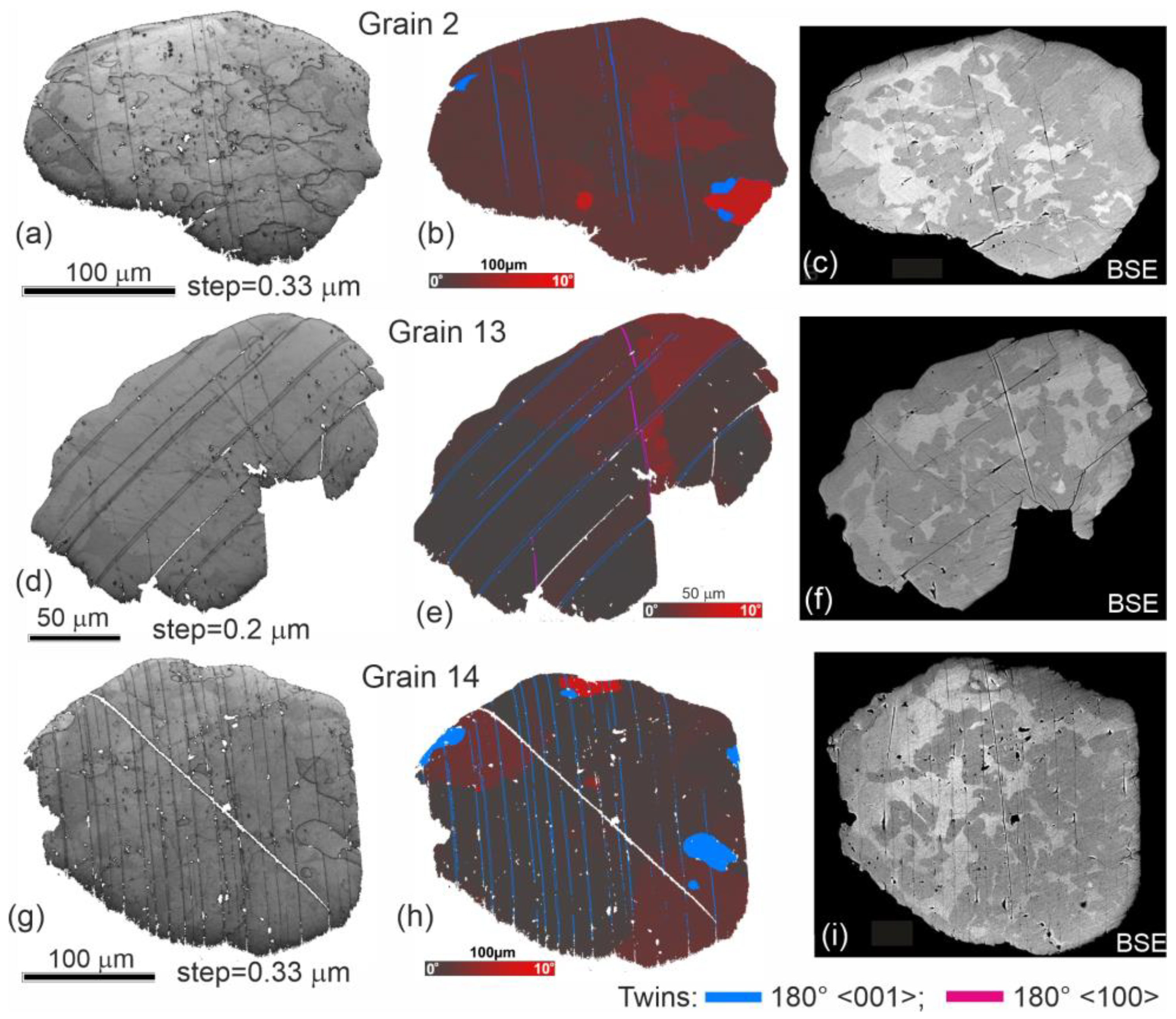
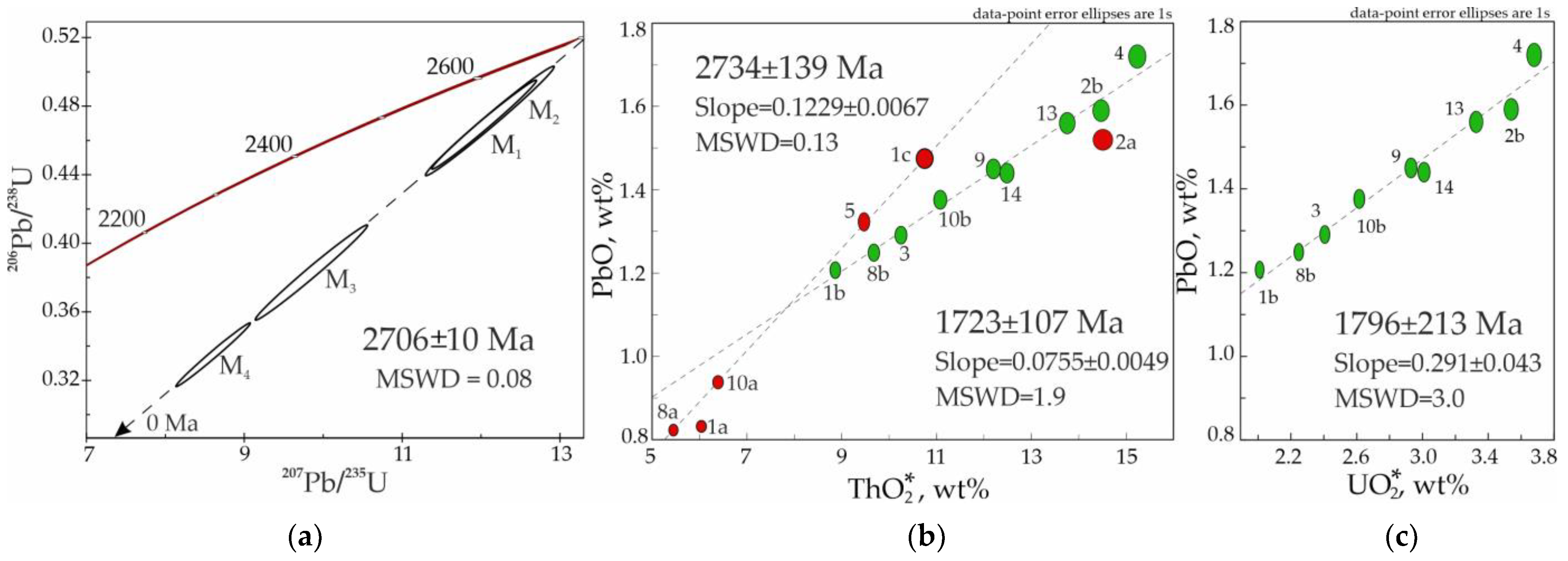
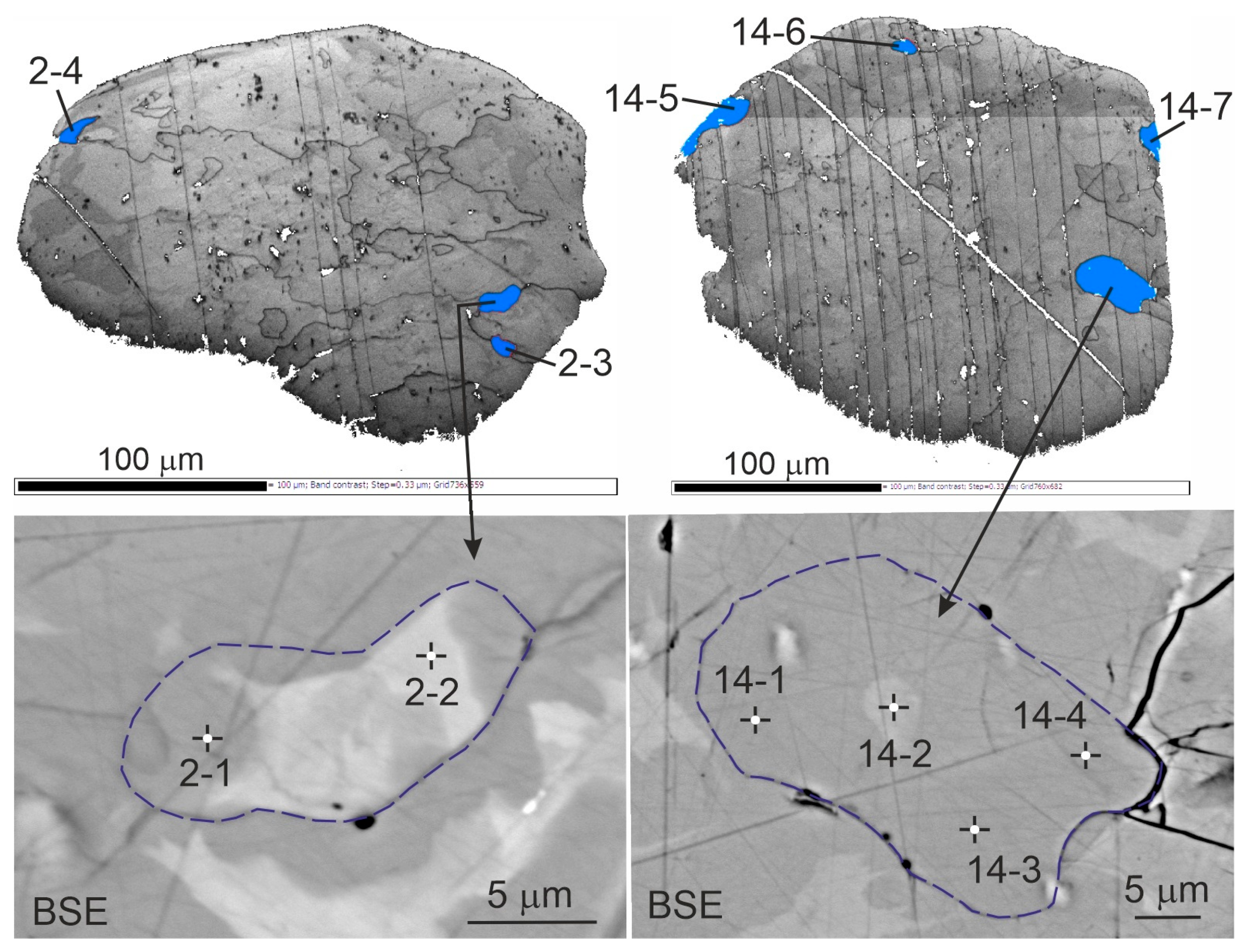
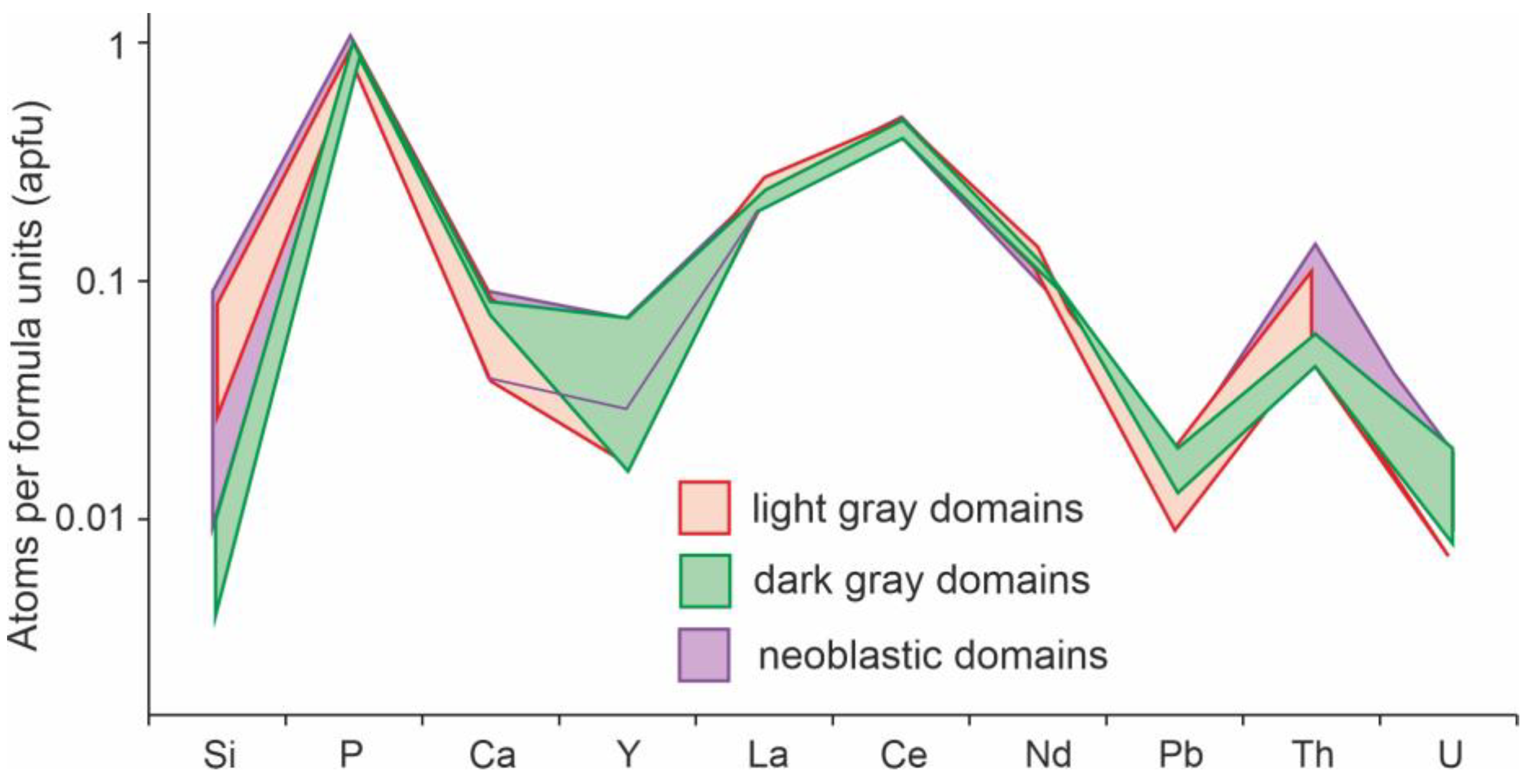
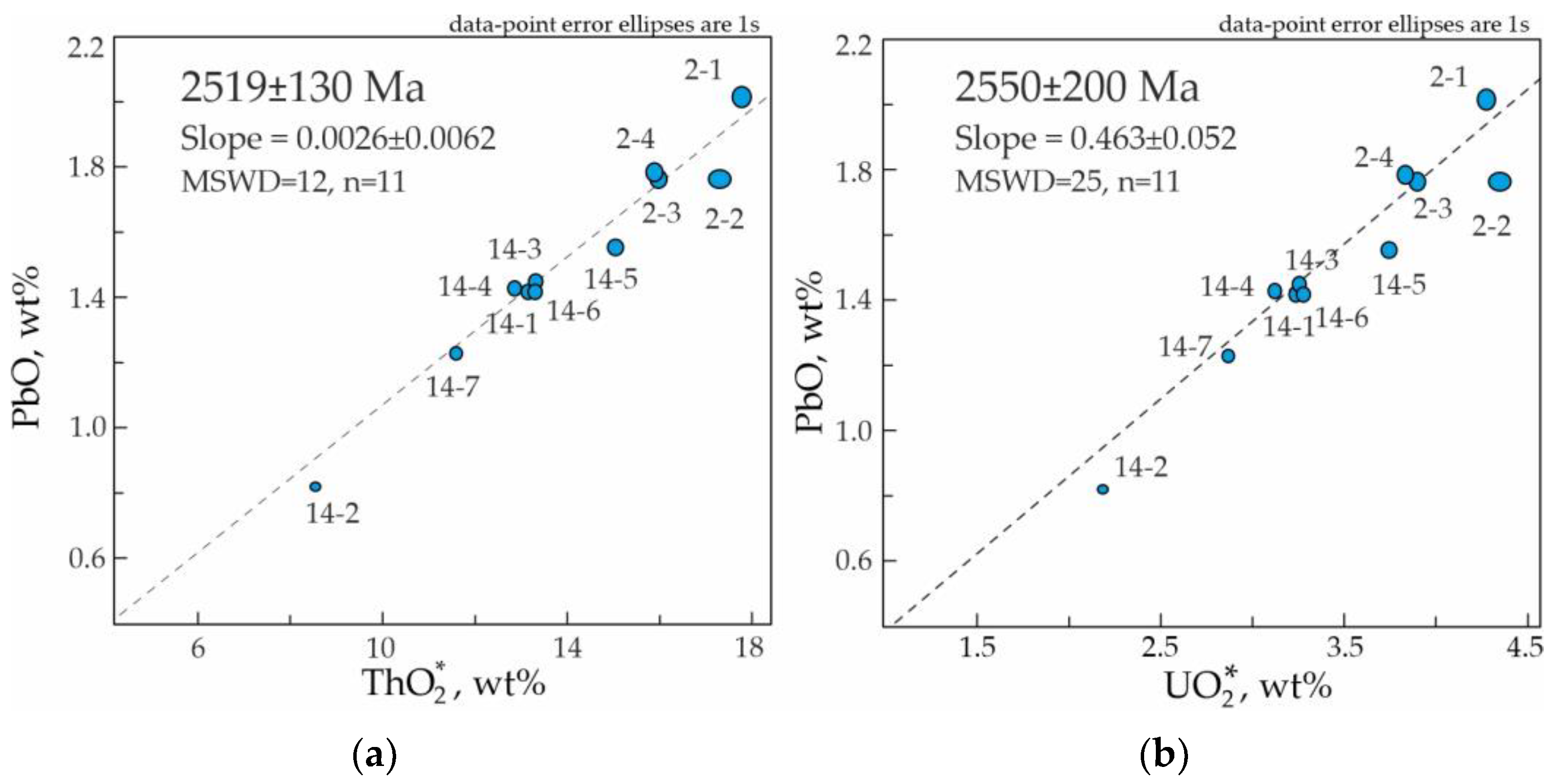
| Components | Number of Analysis | ||||||||||||||
|---|---|---|---|---|---|---|---|---|---|---|---|---|---|---|---|
| 1a | 1b | 1c | 2a | 2b | 3 | 4 | 5 | 8a | 8b | 9 | 10a | 10b | 13 | 14 | |
| SiO2 | 0.65 | 0.12 | 1.64 | 1.90 | 0.18 | 0.10 | 0.24 | 0.11 | 0.66 | 0.05 | 0.11 | 0.89 | 0.26 | 0.27 | 0.23 |
| P2O5 | 26.5 | 29.3 | 27.0 | 26.4 | 28.7 | 29.0 | 29.2 | 30.2 | 27.5 | 27.6 | 29.0 | 29.0 | 30.0 | 29.4 | 29.0 |
| CaO | 0.85 | 1.71 | 1.08 | 1.19 | 1.93 | 1.89 | 1.94 | 2.01 | 0.91 | 1.78 | 1.93 | 1.09 | 2.00 | 1.83 | 1.81 |
| Y2O3 | 0.78 | 2.04 | 1.51 | 1.53 | 3.36 | 2.28 | 3.18 | 1.39 | 2.42 | 0.74 | 2.01 | 1.04 | 2.14 | 2.98 | 2.98 |
| La2O3 | 17.3 | 15.9 | 15.8 | 14.4 | 14.2 | 16.3 | 14.6 | 15.5 | 18.2 | 15.1 | 15.2 | 16.2 | 14.7 | 14.8 | 14.8 |
| Ce2O3 | 31.6 | 29.0 | 29.6 | 27.9 | 27.6 | 28.4 | 28.0 | 28.2 | 28.8 | 31.2 | 28.2 | 30.0 | 27.6 | 28.1 | 28.1 |
| Pr2O3 | 3.11 | 2.49 | 2.56 | 2.39 | 2.43 | 2.24 | 2.27 | 2.43 | 2.82 | 2.51 | 2.57 | 2.30 | 2.27 | 2.31 | 2.35 |
| Nd2O3 | 9.44 | 8.59 | 7.62 | 7.75 | 7.62 | 8.53 | 7.66 | 8.46 | 9.03 | 8.53 | 8.57 | 8.57 | 8.59 | 7.77 | 7.72 |
| Sm2O3 | 1.45 | 1.62 | 1.34 | 1.40 | 1.64 | 1.17 | 1.34 | 1.16 | 1.47 | 1.36 | 1.40 | 1.18 | 1.29 | 1.55 | 1.59 |
| Gd2O3 | 1.18 | 1.22 | 0.70 | 0.86 | 1.23 | 1.19 | 0.94 | 1.09 | 1.10 | 1.15 | 1.29 | 0.92 | 1.14 | 1.09 | 1.22 |
| Dy2O3 | 0.27 | 0.48 | 0.00 | 0.00 | 0.53 | 0.49 | 0.00 | 0.27 | 0.17 | 0.57 | 0.50 | 0.26 | 0.48 | 0.00 | 0.53 |
| PbO | 0.83 | 1.21 | 1.48 | 1.52 | 1.59 | 1.29 | 1.72 | 1.32 | 0.82 | 1.25 | 1.45 | 0.94 | 1.38 | 1.56 | 1.44 |
| ThO2 | 6.04 | 5.06 | 10.9 | 12.3 | 6.50 | 4.87 | 6.54 | 5.75 | 5.45 | 5.54 | 5.22 | 6.39 | 6.73 | 6.81 | 6.47 |
| UO2 | 0.00 | 0.86 | 0.41 | 0.55 | 1.95 | 1.26 | 2.10 | 0.83 | 0.00 | 0.96 | 1.68 | 0.00 | 1.03 | 1.68 | 1.45 |
| Total | 100.0 | 99.6 | 101.7 | 100.0 | 99.5 | 99.0 | 99.8 | 98.8 | 99.3 | 98.4 | 99.1 | 98.7 | 99.7 | 100.1 | 99.6 |
| No | Sample Weight, mg | Concentration, ppm | Pb Isotope Composition | Isotope Ratio | Rho | Age, Ma | ||||||
|---|---|---|---|---|---|---|---|---|---|---|---|---|
| Pbrad | U | 2σ, % | 2σ, % | |||||||||
| M1 | 2.8 | 9432 | 8289 | 14,000 | 5.359 | 0.6197 | 12.030 | 4.5 | 0.4697 | 4.5 | 0.99 | 2705 ± 1 |
| M2 | 2.4 | 10,184 | 8807 | 17,000 | 5.356 | 0.6071 | 12.099 | 5.5 | 0.4718 | 5.5 | 0.99 | 2707 ± 1 |
| M3 | 4.3 | 8459 | 9272 | 13,900 | 5.348 | 0.6396 | 9.841 | 5.9 | 0.3835 | 5.9 | 0.99 | 2708 ± 1 |
| M4 | 3.5 | 7198 | 9023 | 12,600 | 5.354 | 0.6407 | 8.598 | 4.5 | 0.3356 | 4.5 | 0.99 | 2705 ± 1 |
| Components | Number of Analysis | ||||||||||
|---|---|---|---|---|---|---|---|---|---|---|---|
| 2-1 | 2-2 | 2-3 | 2-4 | 14-1 | 14-2 | 14-3 | 14-4 | 14-5 | 14-6 | 14-7 | |
| SiO2 | 0.00 | 2.25 | 0.26 | 0.21 | 0.18 | 0.76 | 0.00 | 0.19 | 0.20 | 0.00 | 0.18 |
| P2O5 | 29.7 | 25.4 | 29.4 | 29.4 | 29.3 | 28.2 | 29.0 | 28.4 | 28.4 | 28.5 | 26.9 |
| CaO | 2.24 | 1.40 | 2.23 | 2.08 | 1.75 | 0.96 | 1.83 | 1.85 | 2.03 | 1.82 | 1.70 |
| Y2O3 | 2.88 | 1.56 | 3.41 | 3.47 | 3.24 | 1.77 | 3.29 | 3.14 | 2.29 | 3.08 | 2.82 |
| La2O3 | 13.9 | 14.2 | 13.8 | 14.2 | 14.6 | 16.5 | 14.7 | 14.6 | 13.8 | 14.2 | 14.6 |
| Ce2O3 | 27.6 | 26.7 | 26.7 | 27. 5 | 28.1 | 31.2 | 28.2 | 28.1 | 28.0 | 27.7 | 27.6 |
| Pr2O3 | 2.37 | 2.33 | 2.37 | 2.37 | 2.45 | 2.54 | 2.39 | 2.6 | 2.51 | 2.41 | 2.35 |
| Nd2O3 | 7.87 | 7.04 | 7.61 | 7.74 | 7.82 | 7.98 | 7.76 | 7.77 | 8.11 | 7.95 | 7.46 |
| Sm2O3 | 1.57 | 1.25 | 1.52 | 1.43 | 1.65 | 1.42 | 1.59 | 1.51 | 1.44 | 1.62 | 1.34 |
| Gd2O3 | 1.05 | 0.86 | 1.19 | 0.79 | 1.04 | 0.79 | 0.98 | 1.06 | 1.03 | 1.18 | 1.04 |
| Dy2O3 | 0.00 | 0.00 | 0.73 | 0.00 | 0.55 | 0.00 | 0.00 | 0.59 | 0.00 | 0.6 | 0.50 |
| PbO | 2.00 | 1.76 | 1.76 | 1.78 | 1.43 | 0.86 | 1.46 | 1.44 | 1.56 | 1.43 | 1.25 |
| ThO2 | 7.45 | 14.6 | 8.28 | 7.12 | 6.30 | 6.46 | 6.37 | 6.31 | 6.86 | 6.45 | 6.29 |
| UO2 | 2.40 | 0.59 | 1.82 | 2.06 | 1.67 | 0.59 | 1.68 | 1.58 | 1.99 | 1.67 | 1.32 |
| Total | 101.6 | 100.0 | 101.1 | 100.1 | 100.0 | 100.0 | 99.2 | 99.2 | 98.2 | 98.6 | 95.3 |
| (Ce0.38–0.46REE0.41–0.48Ca0.04–0.09Th0.06–0.14Pb0.01–0.02U0.01–0.02)1.02–1.06[(P0.89–0.98 Si0–0.03)0.97–0.98O4] | |||||||||||
| Age, Ma 1 | 2662 | 2365 | 2567 | 2640 | 2511 | 2256 | 2555 | 2601 | 2434 | 2503 | 2476 |
Disclaimer/Publisher’s Note: The statements, opinions and data contained in all publications are solely those of the individual author(s) and contributor(s) and not of MDPI and/or the editor(s). MDPI and/or the editor(s) disclaim responsibility for any injury to people or property resulting from any ideas, methods, instructions or products referred to in the content. |
© 2023 by the authors. Licensee MDPI, Basel, Switzerland. This article is an open access article distributed under the terms and conditions of the Creative Commons Attribution (CC BY) license (https://creativecommons.org/licenses/by/4.0/).
Share and Cite
Kaulina, T.; Shilovskih, V.; Nerovich, L.; Savchenko, Y.; Bocharov, V.; Lialina, L.; Il’chenko, V. Microstructural Deformation and the Age of Monazite-(Ce) from Diatectite Granite in the Jarva-Varaka Structure (Kola Region, Russia). Minerals 2023, 13, 1325. https://doi.org/10.3390/min13101325
Kaulina T, Shilovskih V, Nerovich L, Savchenko Y, Bocharov V, Lialina L, Il’chenko V. Microstructural Deformation and the Age of Monazite-(Ce) from Diatectite Granite in the Jarva-Varaka Structure (Kola Region, Russia). Minerals. 2023; 13(10):1325. https://doi.org/10.3390/min13101325
Chicago/Turabian StyleKaulina, Tatiana, Vladimir Shilovskih, Lyudmila Nerovich, Yevgeny Savchenko, Vladimir Bocharov, Lyudmila Lialina, and Vadim Il’chenko. 2023. "Microstructural Deformation and the Age of Monazite-(Ce) from Diatectite Granite in the Jarva-Varaka Structure (Kola Region, Russia)" Minerals 13, no. 10: 1325. https://doi.org/10.3390/min13101325





